Positive Health Online
Your Country

Craniosacral Therapy in Health and Disease
by Jonathan Lawrence(more info)
listed in craniosacral therapy, originally published in issue 222 - May 2015
The significance of the craniosacral system in health has become clearer in the last hundred years with William Garner Sutherland in Osteopathy and De Jarnette in Chiropractic developing analogous techniques. Other authorities such as the late John Upledger and James Jealous have developed the concept further.
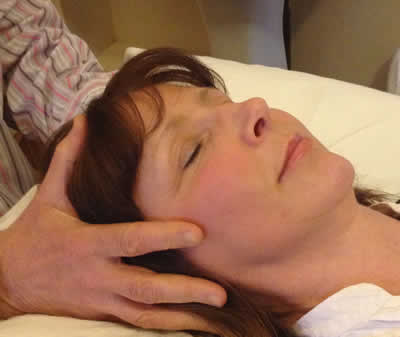
Cranial Manipulation
Sutherland’s concept was that the system was the seat of the Primary Respiratory Mechanism.
1. Primary: It is a system that comes ‘first’. It underlies all of life's processes and gives dynamism, form, and substance to all of anatomy and physiology;
2. Respiratory: It is the spark that gives rise to the breath, as it moves through the tissues. It is the foundation of metabolism. It has both an inhalation and exhalation phase;
3. Mechanism: It is a system composed of many parts that work together to create a whole, greater than the sum of the parts.[1]
While such a concept may be alien to the prevailing mechanistic paradigm, Sutherland attracted many patients many of whom were referred by sceptical colleagues as a last resort. For many patients suffering with variety of conditions from spinal pain to glue ear and sleep disorders this approach as provided a source of relief.
The concept is based on the idea that the fluids and connective tissue in alliance with the central nervous system are a key component in the maintenance and promotion of health and is at odds with the understanding of many conventional health care professionals.
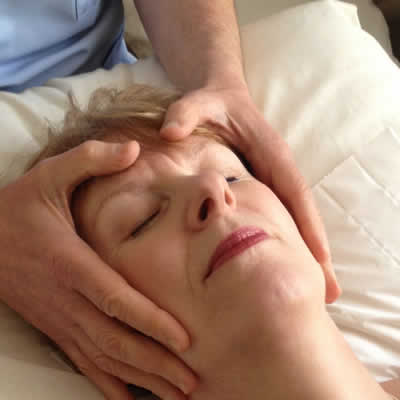
Mandible Treatment
Nevertheless the demand for such services is growing with many informal referrals made via midwives, health visitors and GPs who have seen the results of treatments and would be keen to have these services more widely available. One can also consider that such a low tech and low cost approach could greatly aid burgeoning health costs.
Let us consider the two most important anatomical elements in the practitioners’ ability to manipulate the system: The cerebrospinal fluid (CSF) and the tough layer of meninges surrounding the central nervous system and enclosing the fluid.
According to the visionary founder of osteopath Andrew Taylor Still:
“..the cerebro-spinal fluid is one of the highest known elements that are contained in the body, and unless the brain furnishes this fluid in abundance, a disabled condition of the body will remain. He who is able to reason will see that this great river of life must be tapped and the withering field irrigated at once, or the harvest of health be forever lost.”[2]
CSF is produced by filtration of blood through the blood brain barrier mostly in the choroid plexus and reabsorbed via the large venous sinuses.[3]
The craniosacral therapist picks up a rhythm which is postulated to be an expansion phase in which the CSF is produced more quickly than it can be reabsorbed and a contraction phase in which absorption is switched off. This rhythm is approximately 8-12 times per minute. Upledger thinks that this phase controlled by baroreceptors in the sutures between the cranial bones.[4]
The therapist is able to perceive this motion, which is transmitted throughout tissues and expressed throughout the body. She is therefore able to gauge the mobility of individual tissues. In this way the mobility of cranial bones the sacrum and underlying fascia such as the meninges can be assessed. In addition gentle pressures can allow direction of the fluid motion to release any fixation or immobility in the tissues. Counter intuitively it is not the force that the practitioner engages with the tissues but the accuracy of the vectors of motion of her hands that create the change. Too much force and the tissues resist. The technique is astonishingly gentle.
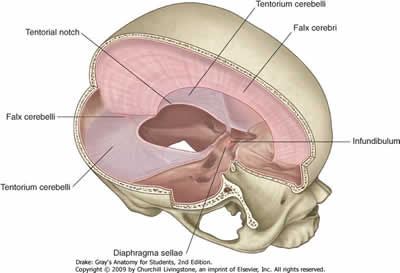
Figure 1. The RTM
Arrangement of the tough meningeal folds in the cranium forming the Reciprocal Tension Membrane,
dividing the cerebral and cerebellar hemispheres and laterally covering the cerebellum.
Disturbance of this balance can lead to adverse symptoms.
The adjustment takes place when the motion of the system stops. This is known as a stillpoint. Upledger[4] notes that fluid exchange takes place at this point, borborygmi (stomach rumbling) takes place, relaxation occurs, the patient often takes a deep breath and homeostasis is promoted. Following a series of stillpoints the system is in better balance with motion being expressed in a more balanced manner. This is achieved because the practitioner works with the innate tendency to healing within the system.
Like many people faced with this concept it took me while to fully understand the power of this approach. Having been trained in mechanistic sciences here was a concept that seemed to lack theoretical and evidential validity. How do you distinguish between a placebo response and a real response? In practice there have been a number of experiences where powerful responses have occurred that were extremely unlikely to have been placebo.
Early in my career I saw a patient suffering from thalamic pain. The diagnosis had been made by some of the top pain specialists in the world and all attempts at treatment including other CAM methods had failed. The pain had come on following severe trauma to the head and face followed by facial maxillary surgery. The pain was constant and very severe.
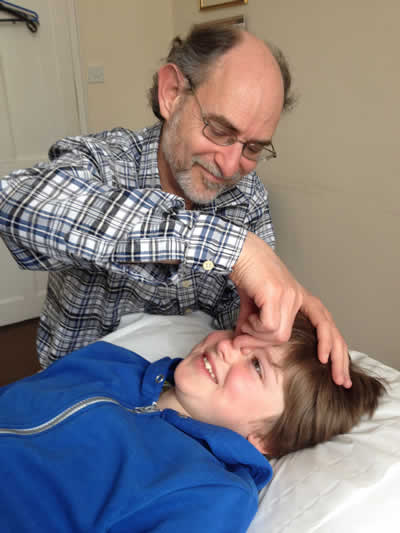
Manipulation of Nasal Septum in Children
Following a case history and examination, palpation and adjustment of the vomer, part of the nasal septum eliminated the pain entirely, initially only during the treatment then for longer and longer periods afterwards. Anatomically it can be seen that mobilization of this structure could have an effect on the thalamus indirectly through connections with the cranial base.
Some years later I saw a profoundly disabled young man who had a condition from birth known as micropthalmia in which the orbits are too small for the eyeball and prostheses are necessary. He presented for distress probably caused by head or neck pain. After a number of treatments I was contacted by the professional responsible for the prostheses, she reported that the orbits had increased in size since he had been having the craniosacral treatment.
She tried in vain to get her consultant interested in a trial to test this approach.
I see a lot of children in practice and one of the commonest problems they manifest is poor hearing.
One of the most memorable cases involved a four-month-old baby who had been diagnosed as profoundly and permanently deaf. After just a few treatments over three months his hearing had become normal. Palpation of the cranium had revealed compression from birth in the region of the temporal (ear) bone. Releasing this compression had allowed the function of the ears to return to normal. The compression had probably been caused by the moulding of the cranium during the second stage of labour.
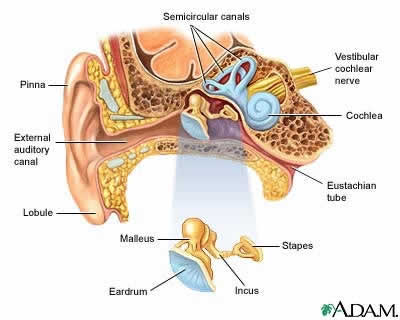
Figure 2 The complex and delicate arrangement of auricular structures.
Derangement of the temporal bones can disturb function here sometimes profoundly.
More commonly I see children who have had a series of ear infections leading to glue ear and the threat or even the reality of grommets which are inserted into the middle ear to allow the glue-like fluid to drain. Recently I have seen couple of infants who have benefitted from treatment, one who did not need surgery after three treatments and another who had had grommets but was still deaf, five treatments being sufficient to improve his hearing.
Children who develop glue ear often have pressure on the ear structures as a result of retained memory in the tissues of the birth process. The compression thus created does not allow the fluids to drain readily from the area causing congestion and making the child vulnerable to ear infections. These in turn create scar tissue, which reduces the space even further.
The child may be lucky and grow out of the problem as the area enlarges with age.
The Craniosacral therapist evaluates the area by palpating the bones of the skull and the underlying structures. The skilled therapist can tell if the bones, sinuses and soft tissues are mobile, detecting the motion through the flow of cerebrospinal fluid (CSF) which causes an expansion and contraction of the tissues.
Disturbed motion or immobility in the tissues often correlated with the symptoms. The therapist the gently eases the tissues using feather light but precise pressures easing the restriction. Babies and children usually enjoy the treatment and are very cooperative, often sighing at the point of release. Relief of symptoms usually occurs within a treatment or two.
Even in adults deafness can sometimes be eased using this technique. The associated effects of this kind of dysfunction in the temporal bones can be linked to jaw and teeth problems, also headaches and sinus problems as these structures are interlinked. Treatment at an early age can help to mitigate or prevent these problems.
This article sets out just a taste of a therapy less than a hundred years old that is in a state of rapid evolution that is proving popular and beneficial. A therapy that has the potential to help prevent and treat a range of conditions related to disturbed structure. Proper use of such an approach could ease some of the burden currently being carried by our health system.
References
1. www.osteodoc.com/sutherland.htm
2. http://osteopathichistory.com/pagesside2/Analects.html
3. http://en.wikipedia.org/wiki/Cerebrospinal_fluid
4. Upledger, Vredevoogd. Craniosacral Therapy. Eastland Press. Seattle. ISBN 0-939616-01-7
Comments:
-
No Article Comments available